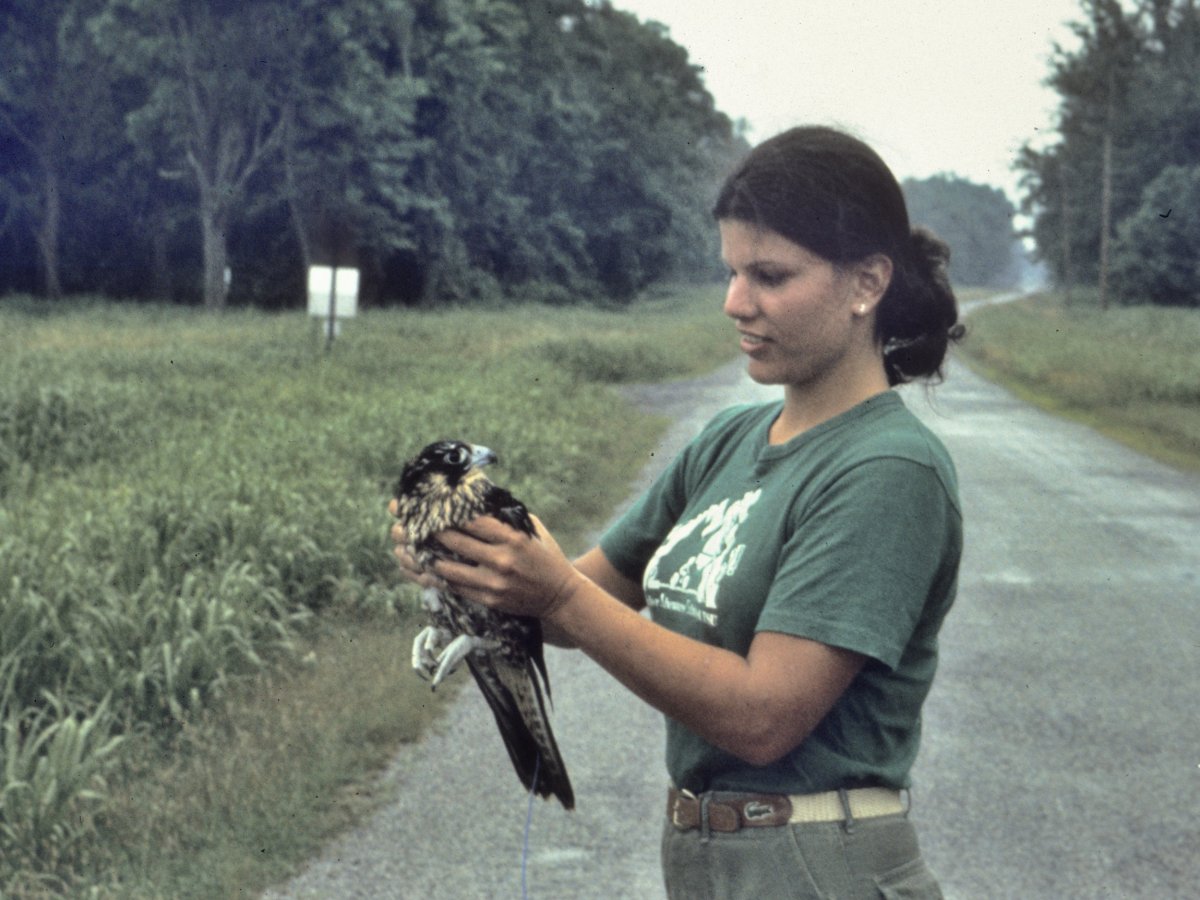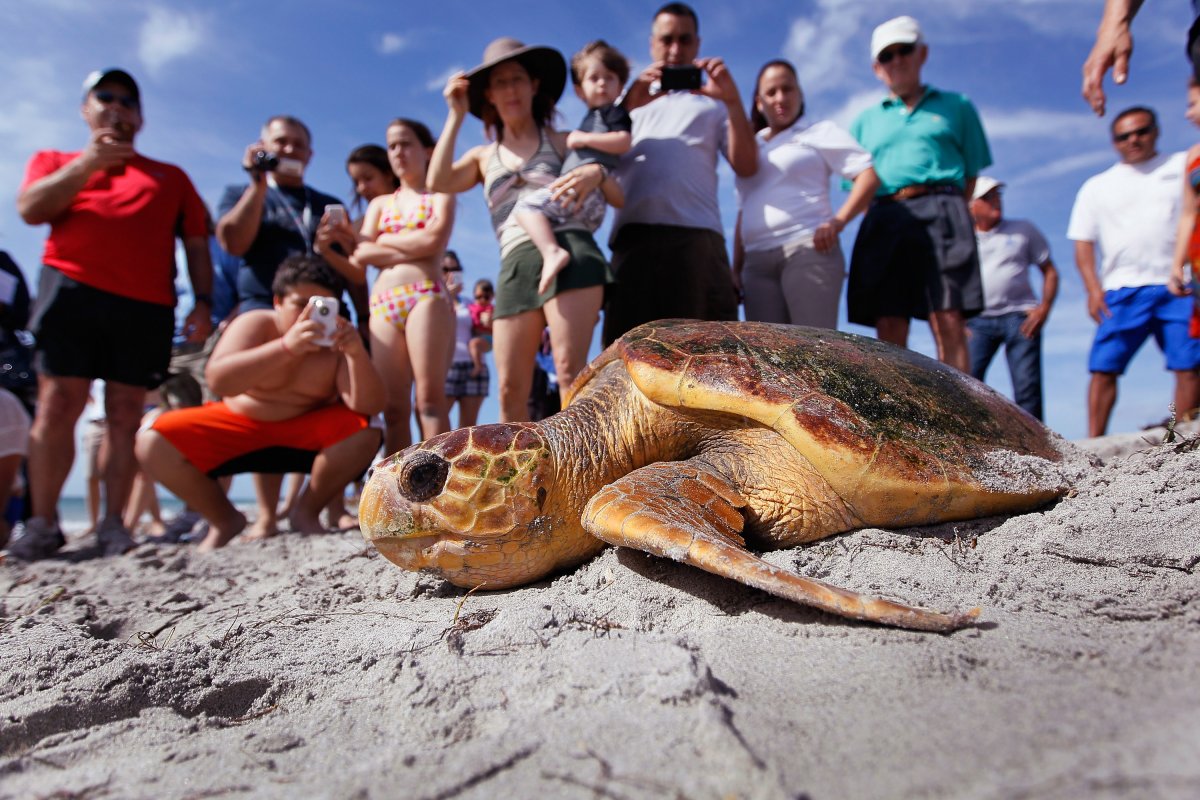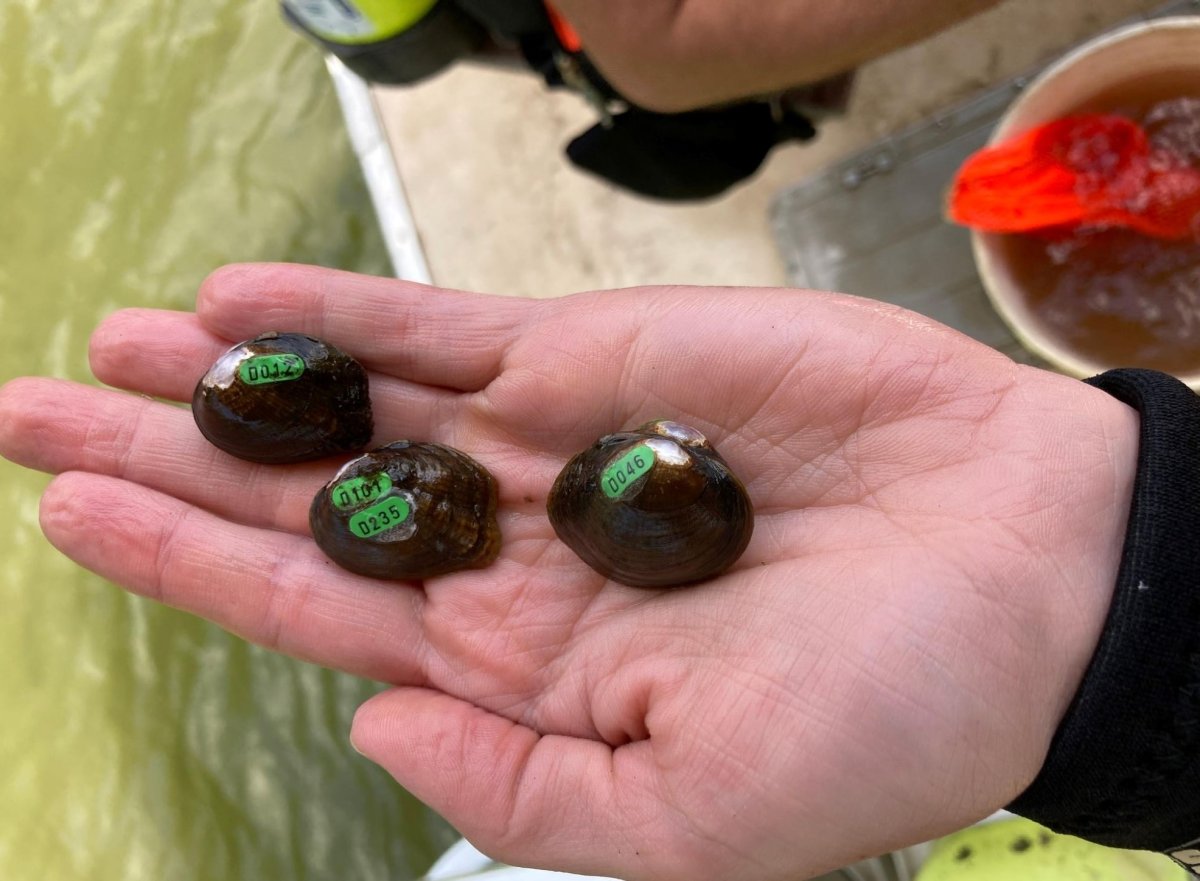Fifty years ago this week, President Richard M. Nixon signed into law one of the most powerful and profound pieces of environmental legislation in history—the Endangered Species Act.
“To better safeguard, for the benefit of all citizens, the Nation’s heritage in fish, wildlife, and plants,” the Act stated in its opening section, federal agencies would “seek to conserve endangered species and threatened species.”
Half a century later, the Endangered Species Act (ESA) has kept hundreds of species from blinking out of existence and has helped dozens of them return to a healthy status.
A comprehensive study from 2019 found that the ESA has prevented the likely extinction of 291 species, and 39 species have been fully recovered, meaning they are now numerous enough that they no longer need the ESA’s protection. The researchers found that the law has saved more than 99 percent of species under its protection.
Newsweek Illustration/Getty Images and U.S. Fish & Wildlife Service
The Act has had its share of controversy, such as the 1978 delay of a dam’s construction in Tennessee due to a small fish called the snail darter, and the “timber wars” of the 1990s that followed habitat protection for the northern spotted owl in the Pacific Northwest. But with success stories including the resurgence of iconic American animals such as the bald eagle and American alligator, it’s hard to imagine our country without the protection the Act offers.
To mark 50 years of the ESA, Newsweek asked some conservation scientists to share their favorite endangered species success stories. The examples they chose demonstrate how the law empowered people to save species, and how working on behalf of those plants and animals can change the course of people’s lives.
Peregrine Falcon
Jamie Rappaport Clark is CEO of the environmental group Defenders of Wildlife and directed the U.S. Fish and Wildlife Service during the Clinton administration. But long before all of that, Clark was a college student on track to become a veterinarian. Then she spent a summer working with peregrine falcons.
“It shaped my entire career,” she told Newsweek.
Like many birds of prey, the peregrine falcon’s ability to reproduce was harmed by the toxic buildup in the food web of some pesticides such as DDT. Once the pesticides were banned in the early ’70s, the bird began to rebound with the help of breeding and reintroduction programs. In the late 1970s, Clark worked with just such a program rearing peregrine chicks.

Courtesy Jamie Rappaport Clark
“We were hand raising and releasing them,” Clark said. “And I thought, ‘This is what it’s all about. Saving species from the brink of extinction.'”
She shifted the focus of her study and earned degrees in wildlife biology and ecology. She eventually rose to the top of one of the agencies charged with administering the ESA, the Fish and Wildlife Service.
During her tenure as the Service’s director, Clark was able to declare the peregrine falcon’s successful recovery in 1999.
“I went from a college kid working with these peregrine chicks to—fast forward 20 years later—I’m standing at the World Center for Birds of Prey in Boise, Idaho, on the cliffs of the Snake River, announcing the recovery of the peregrine falcon under the Endangered Species Act,” Clark said.
It’s the sort of story that befits an awe-inspiring animal. The peregrine falcon is the world’s fastest living thing, reaching speeds well over 200 mph when diving after prey. The falcon nests on cliffsides and, since its recovery, has expanded its range to include several cities where it nests on the ledges of tall buildings.
“The bird is special for me,” Clark said. “I saw the full circle in my career, from a bird on the brink, where we were hand raising and releasing them, to, ‘It’s done. It’s a success.’ And it was the Endangered Species Act that really triggered and harnessed and catalyzed that nationwide recovery effort.”
Loggerhead Sea Turtle
Sally Murphy also credits much of her career in conservation to her work with one endangered animal, the loggerhead sea turtle.
“I mean, I’m the turtle lady,” she told Newsweek. Indeed, if you read much about sea turtle conservation in the Southeast, you’ll likely come across Murphy’s name.
Murphy joined the South Carolina Department of Natural Resources as an environmental education specialist shortly after finishing her advanced degree in the early 1970s but found the work unfulfilling.
“I felt like all the knowledge I’d gotten in graduate school was just turning to mush in my brain,” she said, so she asked for a transfer to work with endangered species along the coast. That’s where she created the state’s sea turtle conservation program.
“When I first started working with the loggerhead, very little was known about it,” she said. Monitoring beaches and coastal waters, she got a better understanding of what was harming sea turtle populations. Eggs and hatchlings were being lost on beaches when nests were disturbed and adult turtles were being drowned at sea, especially by the nets of shrimp trawlers.

Joe Raedle/Getty Images
Murphy mounted a Churchillian defense, fighting on the beaches and on the sea. She organized volunteers who monitored and protected nests, placing screens over them to prevent predation and relocating eggs if the nests were in risky spots.
“That greatly increased the production of hatchlings,” Murphy said. But she knew the long timeframe of the turtle’s biology meant that it could be decades before most of those hatchlings would return to nest again. Hatchlings entering the ocean along the Carolina coast get swept into the Gulf Stream and taken for a transoceanic ride.
“They get carried over to the Azores and some even into the western Mediterranean,” Murphy explained. “Once our loggerheads reach a certain size, they come back over here.”
Restoring the species would require more than just waiting for those little hatchlings to grow and make the long return trip. More of the already mature turtles had to safely reach nesting beaches instead of drowning in fishing nets. That meant Murphy had to fight on the water as well. She got help from an unlikely source.
“A shrimper down in Georgia named Sinkey Boone,” she said (and yes, she insists, that was his real name). Boone had added a grill device to his nets to allow shrimp to enter while deflecting larger objects like jellyfish, preventing clogging.
“When I saw that thing, I said, ‘Aha! This is the answer,'” Murphy said, and the Turtle Excluder Device was born, a simple addition to shrimp nets that keeps turtles out. “South Carolina became the first state to require Turtle Excluder Devices in shrimp trawlers,” she said.
The combination of nest protection on beaches and net excluding devices at sea helped the loggerhead begin to bounce back, she said. A full recovery will take time, but Murphy is confident that people inspired by the turtle will help conserve it.
“Reptiles aren’t exactly warm and fuzzy, but I guess it’s more of an admiration for just what these animals are capable of doing,” she said. The turtles have amazing navigation skills using their ability to detect the Earth’s magnetic field in order to find their way across the ocean. Some live more than 60 years and females typically only come on land to lay eggs.
Murphy said she is heartened by the international community of sea turtle researchers and the small army of volunteers who monitor South Carolina’s coast.
“They’re zealots, they’re up at dawn patrolling the beach among rain and skeeters, and you name it,” she said. “That’s what makes you say, ‘The turtles are going to be OK. They’re going to make it.'”
Purple Cat’s Paw Pearlymussel
Tierra Curry is a senior scientist with the nonprofit conservation group Center for Biological Diversity, where she works primarily with species of freshwater mussels.
“Freshwater mussels are the most endangered group of animals in the United States,” Curry told Newsweek. “Seventy percent of them are in an extinction risk category but only 30 percent of them are protected.”
Mussels are among the often overlooked small organisms that play an outsized role in nature—what biologist E.O. Wilson referred to as “the little things that run the world.” Curry explained that mussels form an important part of the aquatic food web, and their filter feeding helps clean streams and rivers.
“They help reduce the cost of water filtration for communities because they clear up the water and they stabilize streambanks,” she said.
Naturalists naming freshwater mussels seemed to have had a sense of humor. There are mussels named wartyback, fatmucket, pigtoe—or, in the case of Curry’s favorite species success story—the purple cat’s paw pearlymussel.

Elaine Barr/Courtesy U.S. Fish and Wildlife Service
“The purple cat’s paw pearlymussel was such a great story because scientists thought that it was extinct,” she said. It wasn’t until a stream survey in 1994 that researchers discovered a small population still living in a central Ohio waterway called Killbuck Creek. Those mussels would seed a widespread reintroduction of the species to its native range, but only after some very clever biological homework.
Water pollution and dams are the main threats to most mussels, but that’s not the only challenge in reviving them. Restoring severely depleted species also involves understanding their unique co-evolution with neighboring fish and the mussels’ constant struggle against the current.
Mussels reproduce by releasing young into the water. But in a flowing stream, those young would wash downstream indefinitely. So how do mussels manage to reproduce in place or expand upstream?
“They have a couple of different tricks up their sleeves,” Curry explains. “One of them is they make a lure that sticks out of their shell.”
A growth on the mussel can resemble a fish’s prey, such as an aquatic insect or small fish. When a hungry fish approaches the lure, the mussel releases the fertilized eggs, which stick to the gills of the host fish. After the young mussels have grown enough, they drop from the fish gills and carry on the rest of their life cycle, having hitched a ride on the host fish long enough to fight against the relentless current of the stream.
Biologists working in a partnership among the federal government, state agencies and research universities learned how to propagate the purple cat’s paw pearlymussel—work made possible by the protection the ESA provides.
“That’s the only reason they’re still here,” Curry said.
Osprey
The osprey is so abundant along most shorelines, rivers and lakes today that it’s easy to forget that not long ago it was a rare sight.
“They should have been really common in the region where I lived, but they were just about completely gone,” Carl Safina told Newsweek. Safina is an ecologist and prolific nature writer who teaches at Stony Brook University in New York.
An avid birder from an early age, Safina said he can remember his first two osprey sightings on New York’s Long Island.
“The first osprey that I saw was when I was 15, and the second osprey that I saw was at 21 years old,” he said. Two sightings in six years, Safina said, and that was during a youth spent largely on the water. “I went fishing on the shores of Long Island every weekend during six months of the year.”

T. Ulrich/Getty Images
Like the peregrine falcon and bald eagle, the osprey was affected by DDT and other pesticides that hindered the birds’ ability to form hard shells on their eggs. Today, the osprey has come roaring back thanks to the Act’s protection and the ban on pesticides like DDT.
“They’re beautiful, they’re dramatic,” Safina said of the birds. “You don’t usually get to see animals actually catch food, but you frequently see them making these spectacular plunges into the water and coming up with a fish.”
Safina said the osprey’s return shows how the ESA saves more than just species. Entire landscapes can be restored when vital pieces return, and the vital piece could be as noble as the osprey or humble as a freshwater mussel.
“The law says that all living things have a right to be in this world,” Safina said. That’s a profound legal statement, he said, and one that’s difficult to imagine arising from today’s fractured political environment. “The law came from a more generous time when the United States had the power and the confidence to say that we will preserve all of our living legacy.”
The Next 50 Years
Safina, Clark and Curry reflected on conservation in the coming 50 years, and whether the ESA can continue to prevent extinction as it has in the last half-century.
A wildlife protection system that only acts on species in danger of extinction, Safina argued, is akin to a health system that offers only emergency rooms.
“We should have an abundant species act, not just an Endangered Species Act,” he said.
Defenders of Wildlife’s Clark agreed. She said the group must fight off budget cuts and other attempts by lawmakers to restrict the ESA’s reach, all while the list of candidate species that need protection grows longer.
“The Endangered Species Act is the last stop,” Clark said. “It has been doing a dramatically good job to prevent extinction, but it can’t do this by itself.”
The ESA’s success is especially remarkable against the global backdrop of species loss, a worldwide crisis of biodiversity destruction. Many ecologists call this the Earth’s sixth great extinction period, and the first one caused by a single species—us.
The big picture can be overwhelming, Curry said, as habitat loss and climate change push more plants and animals to the brink.
“We are in an extinction crisis, but that doesn’t mean we throw up our hands and do nothing,” she said. She thinks of more stories of species we have saved and takes hope. “That larger picture is also made up of all of the smaller stories.”


